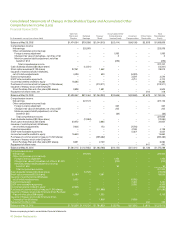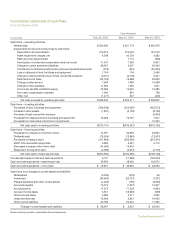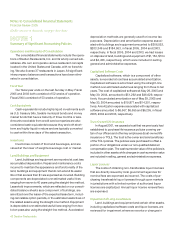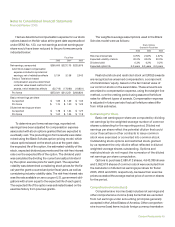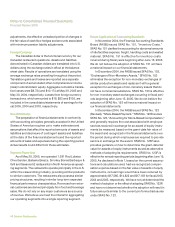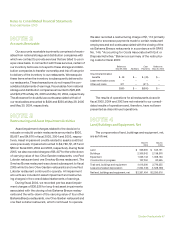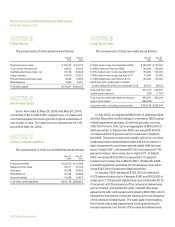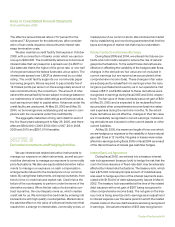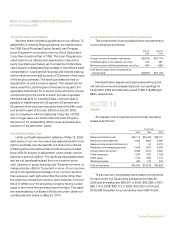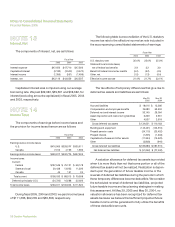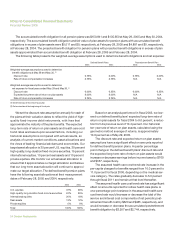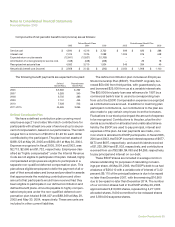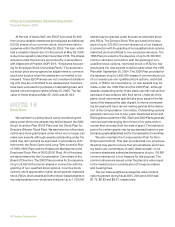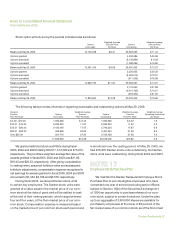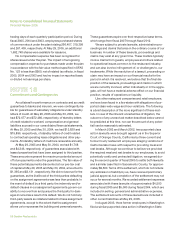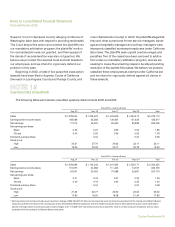Red Lobster 2005 Annual Report Download - page 41
Download and view the complete annual report
Please find page 41 of the 2005 Red Lobster annual report below. You can navigate through the pages in the report by either clicking on the pages listed below, or by using the keyword search tool below to find specific information within the annual report.Notes to Consolidated Financial Statements
Financial Review 2005
Darden Restaurants 49
The effective annual interest rate is 7.57 percent for the
notes and 7.82 percent for the debentures, after consider-
ation of loan costs, issuance discounts and interest-rate
swap termination costs.
We also maintain a credit facility that expires in October
2008, with a consortium of banks under which we can bor-
row up to $400,000. The credit facility allows us to borrow at
interest rates that vary based on a spread over (i) LIBOR or
(ii) a base rate that is the higher of the prime rate, or one-half
of one percent above the federal funds rate, at our option. The
interest rate spread over LIBOR is determined by our debt
rating. The credit facility supports our commercial paper
borrowing program. We are required to pay a facility fee of
12.5 basis points per annum on the average daily amount of
loan commitments by the consortium. The amount of inter-
est and the annual facility fee are subject to change based on
our maintenance of certain debt ratings and financial ratios,
such as maximum debt to capital ratios. Advances under the
credit facility are unsecured. At May 29, 2005 and May 30,
2004, no borrowings were outstanding and we were in com-
pliance with the covenants under this credit facility.
The aggregate maturities of long-term debt for each of
the five fiscal years subsequent to May 29, 2005, and there-
after are $300,000 in 2006, $150,000 in 2007, $0 in 2008,
2009 and 2010 and $201,010 thereafter.
NOTE 9
Derivative Instruments and Hedging Activities
We use interest rate related derivative instruments to
manage our exposure on debt instruments, as well as com-
modities derivatives to manage our exposure to commodity
price fluctuations. We also use equity related derivative instru-
ments to manage our exposure on cash compensation
arrangements indexed to the market price of our common
stock. By using these instruments, we expose ourselves, from
time to time, to credit risk and market risk. Credit risk is the
failure of the counterparty to perform under the terms of the
derivative contract. When the fair value of a derivative con-
tract is positive, the counterparty owes us, which creates
credit risk for us. We minimize this credit risk by entering into
transactions with high quality counterparties. Market risk is
the adverse effect on the value of a financial instrument that
results from a change in interest rates, commodity prices, or
market price of our common stock. We minimize this market
risk by establishing and monitoring parameters that limit the
types and degree of market risk that may be undertaken.
Futures Contracts and Commodity Swaps
During fiscal 2005 and 2004, we entered into futures con-
tracts and commodity swaps to reduce the risk of natural
gas price fluctuations. To the extent these derivatives are
effective in offsetting the variability of the hedged cash flows,
changes in the derivatives’ fair value are not included in
current earnings but are reported as accumulated other
comprehensive income (loss). These changes in fair value
are subsequently reclassified into earnings when the natu-
ral gas is purchased and used by us in our operations. Net
losses of $311 and $439 related to these derivatives were
recognized in earnings during fiscal 2005 and 2004, respec-
tively. The fair value of these contracts was a net gain of $60
at May 29, 2005 and is expected to be reclassified from
accumulated other comprehensive income (loss) into restau-
rant expenses during the next nine months. To the extent
these derivatives are not effective, changes in their fair value
are immediately recognized in current earnings. Outstand-
ing derivatives are included in other current assets or other
current liabilities.
At May 29, 2005, the maximum length of time over which
we are hedging our exposure to the variability in future natural
gas cash flows is 12 months. No gains or losses were reclas-
sified into earnings during fiscal 2005 or fiscal 2004 as a result
of the discontinuance of natural gas cash flow hedges.
Interest Rate Lock Agreement
During fiscal 2002, we entered into a treasury interest
rate lock agreement (treasury lock) to hedge the risk that the
cost of a future issuance of fixed-rate debt may be adversely
affected by interest rate fluctuations. The treasury lock, which
had a $75,000 notional principal amount of indebtedness,
was used to hedge a portion of the interest payments asso-
ciated with $150,000 of debt subsequently issued in March
2002. The treasury lock was settled at the time of the related
debt issuance with a net gain of $267 being recognized in
other comprehensive income (loss). The net gain on the trea-
sury lock is being amortized into earnings as an adjustment
to interest expense over the same period in which the related
interest costs on the new debt issuance are being recognized
in earnings. Annual amortization of $53 was recognized in



